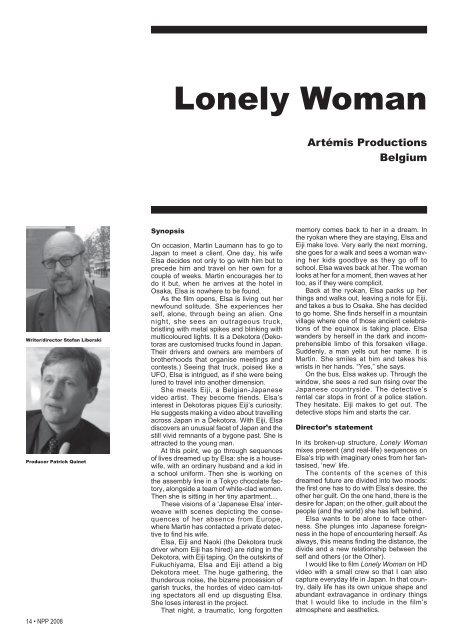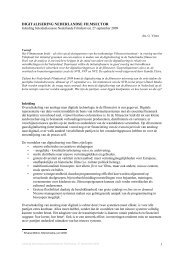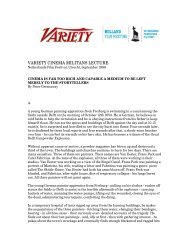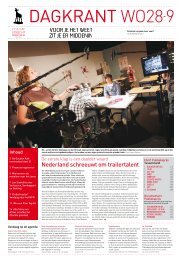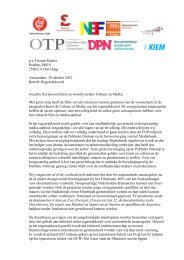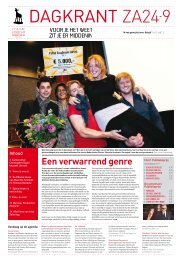Netherlands Production Platform - Nederlands Film Festival
Netherlands Production Platform - Nederlands Film Festival
Netherlands Production Platform - Nederlands Film Festival
You also want an ePaper? Increase the reach of your titles
YUMPU automatically turns print PDFs into web optimized ePapers that Google loves.
Lonely Woman<br />
Artémis <strong>Production</strong>s<br />
Belgium<br />
Writer/director Stefan Liberski<br />
Producer Patrick Quinet<br />
14 • NPP 2008<br />
Synopsis<br />
On occasion, Martin Laumann has to go to<br />
Japan to meet a client. One day, his wife<br />
Elsa decides not only to go with him but to<br />
precede him and travel on her own for a<br />
couple of weeks. Martin encourages her to<br />
do it but, when he arrives at the hotel in<br />
Osaka, Elsa is nowhere to be found.<br />
As the film opens, Elsa is living out her<br />
newfound solitude. She experiences her<br />
self, alone, through being an alien. One<br />
night, she sees an outrageous truck,<br />
bristling with metal spikes and blinking with<br />
multicoloured lights. It is a Dekotora (Dekotoras<br />
are customised trucks found in Japan.<br />
Their drivers and owners are members of<br />
brotherhoods that organise meetings and<br />
contests.) Seeing that truck, poised like a<br />
UFO, Elsa is intrigued, as if she were being<br />
lured to travel into another dimension.<br />
She meets Eiji, a Belgian-Japanese<br />
video artist. They become friends. Elsa’s<br />
interest in Dekotoras piques Eiji’s curiosity.<br />
He suggests making a video about travelling<br />
across Japan in a Dekotora. With Eiji, Elsa<br />
discovers an unusual facet of Japan and the<br />
still vivid remnants of a bygone past. She is<br />
attracted to the young man.<br />
At this point, we go through sequences<br />
of lives dreamed up by Elsa: she is a housewife,<br />
with an ordinary husband and a kid in<br />
a school uniform. Then she is working on<br />
the assembly line in a Tokyo chocolate factory,<br />
alongside a team of white-clad women.<br />
Then she is sitting in her tiny apartment…<br />
These visions of a ‘Japanese Elsa’ interweave<br />
with scenes depicting the consequences<br />
of her absence from Europe,<br />
where Martin has contacted a private detective<br />
to find his wife.<br />
Elsa, Eiji and Naoki (the Dekotora truck<br />
driver whom Eiji has hired) are riding in the<br />
Dekotora, with Eiji taping. On the outskirts of<br />
Fukuchiyama, Elsa and Eiji attend a big<br />
Dekotora meet. The huge gathering, the<br />
thunderous noise, the bizarre procession of<br />
garish trucks, the hordes of video cam-toting<br />
spectators all end up disgusting Elsa.<br />
She loses interest in the project.<br />
That night, a traumatic, long forgotten<br />
memory comes back to her in a dream. In<br />
the ryokan where they are staying, Elsa and<br />
Eiji make love. Very early the next morning,<br />
she goes for a walk and sees a woman waving<br />
her kids goodbye as they go off to<br />
school. Elsa waves back at her. The woman<br />
looks at her for a moment, then waves at her<br />
too, as if they were complicit.<br />
Back at the ryokan, Elsa packs up her<br />
things and walks out, leaving a note for Eiji,<br />
and takes a bus to Osaka. She has decided<br />
to go home. She finds herself in a mountain<br />
village where one of those ancient celebrations<br />
of the equinox is taking place. Elsa<br />
wanders by herself in the dark and incomprehensible<br />
limbo of this forsaken village.<br />
Suddenly, a man yells out her name. It is<br />
Martin. She smiles at him and takes his<br />
wrists in her hands. “Yes,” she says.<br />
On the bus, Elsa wakes up. Through the<br />
window, she sees a red sun rising over the<br />
Japanese countryside. The detective’s<br />
rental car stops in front of a police station.<br />
They hesitate. Eiji makes to get out. The<br />
detective stops him and starts the car.<br />
Director’s statement<br />
In its broken-up structure, Lonely Woman<br />
mixes present (and real-life) sequences on<br />
Elsa’s trip with imaginary ones from her fantasised,<br />
‘new’ life.<br />
The contents of the scenes of this<br />
dreamed future are divided into two moods:<br />
the first one has to do with Elsa’s desire, the<br />
other her guilt. On the one hand, there is the<br />
desire for Japan; on the other, guilt about the<br />
people (and the world) she has left behind.<br />
Elsa wants to be alone to face otherness.<br />
She plunges into Japanese foreignness<br />
in the hope of encountering herself. As<br />
always, this means finding the distance, the<br />
divide and a new relationship between the<br />
self and others (or the Other).<br />
I would like to film Lonely Woman on HD<br />
video with a small crew so that I can also<br />
capture everyday life in Japan. In that country,<br />
daily life has its own unique shape and<br />
abundant extravagance in ordinary things<br />
that I would like to include in the film’s<br />
atmosphere and aesthetics.


